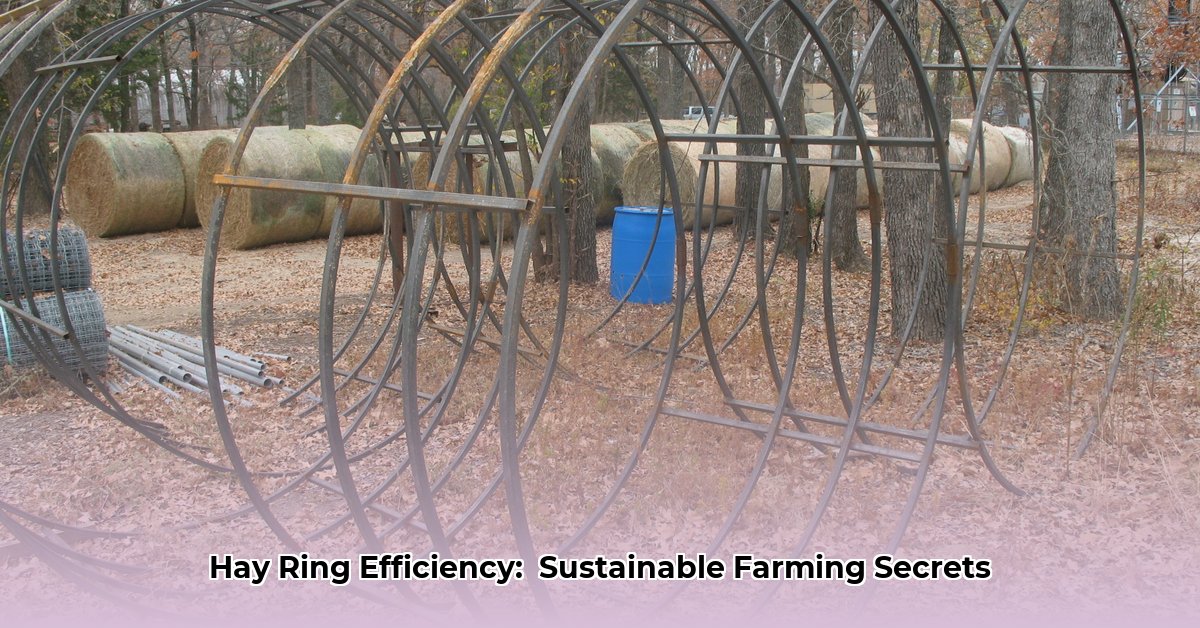
Maximize Hay Ring Efficiency: A Guide for Sustainable Farming
Getting the most from your hay is key to profitable and environmentally responsible farming. Smart hay management begins with the right equipment, and Tractor Supply's hay rings offer a practical solution. This guide will help you choose, use, and maintain a hay ring effectively, minimizing waste and maximizing your return on investment. We'll explore options from brands like CountyLine and Behlen Country, helping you find the perfect fit for your operation. For more on hay ring options, check out this helpful resource: Tractor Hay Rings.
Choosing the Right Hay Ring: Considerations for Success
Selecting the right hay ring requires careful thought. Don't just grab the first one you see! Consider these factors:
- Animal Size and Type: Larger animals like cows need robust rings, while smaller horses may suffice with a lighter-duty model. A poorly constructed ring won't stand up to substantial weight.
- Hay Usage and Type: The size of your hay bales and the number of animals influence the optimal ring size and capacity. A small ring won't meet the needs of a large herd.
- Location and Terrain: Place your ring on level, accessible ground. Consider the ring's weight; maneuverability is crucial, especially in challenging terrain. A heavy ring in a muddy field will be a major inconvenience.
- Budget: Tractor Supply offers a wide price range, ensuring affordability without compromising quality.
Choosing the right hay ring is like choosing the right tool for a job; the wrong one makes the entire process more difficult and less efficient. A well-chosen ring, however, contributes to smooth, profitable operations. Have you considered the long-term cost savings of a durable hay ring compared to cheap, frequently replaced options?
Optimizing Hay Ring Usage: Practical Steps for Efficiency
Once you have your hay ring, follow these steps to maximize its effectiveness:
- Strategic Placement: Position the ring where animals can easily access it, preventing wasted energy and ensuring fair distribution of hay. A central location is typically best.
- Organized Hay Loading: Use a hay spear or loader for neat placement. Avoid overcrowding and spillage for easier access and less wasted feed.
- Regular Maintenance: Inspect your ring regularly for damage. Repair or replace broken parts promptly to ensure its safety and longevity. Prevention is far more cost-effective than repairs.
- Waste Monitoring: Track hay waste to pinpoint areas for improvement. Observe your animals' feeding habits and adjust your strategy accordingly. Reduced waste translates directly to increased profitability and reduced environmental impact.
- Integration with Other Feeding Systems: Consider supplementing your hay ring with other feeding systems to cater to your animals' needs and preferences. Variety can optimize feeding efficiency.
Did you know that minimizing hay waste can translate to significant cost savings? Efficient hay management is crucial for optimized profitability.
The Environmental Impact: Sustainable Farming Practices
Efficient hay ring use isn't solely about cost savings; it's a cornerstone of sustainable agriculture. Reducing waste lessens the demand for hay production, leading to reduced land use, water consumption, and a smaller carbon footprint. These small changes build to a larger environmental benefit.
Expanding Your Sustainable Practices: A Holistic Approach
While efficient hay feeding is pivotal, it's one piece of the sustainable farming puzzle. Consider these additional strategies:
- Sustainable Feed Sources: Prioritize locally grown and organically produced feed whenever possible. This supports local farmers and reduces transportation emissions.
- Rotational Grazing: Implement rotational grazing to improve soil health and prevent overgrazing.
- Water Conservation: Invest in water-saving techniques for watering systems.
Sustainable farming is a journey, not a destination. Start with simple changes, and gradually incorporate more sustainable practices. Small improvements add up to substantial long-term gains.
How to Reduce Livestock Feed Waste with Efficient Feeders: Key Takeaways
- Minimizing hay waste yields significant cost savings.
- Proper hay storage is essential; cover bales and ensure appropriate storage conditions.
- The right feeder makes a huge difference; sheeted-bottom or cone feeders dramatically reduce waste compared to open-bottom designs.
- Controlled feeding schedules limiting hay access minimize overeating and waste.
- Investing in efficient feeders offers substantial long-term returns.
Dr. Emily Carter, Extension Specialist in Animal Science at the University of Illinois, emphasizes, "The right feeder can significantly reduce hay waste, and that translates directly to your bottom line." Consider this before making your hay-feeding equipment choices. What financial impact is potential hay waste having on your operation?